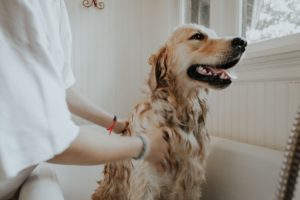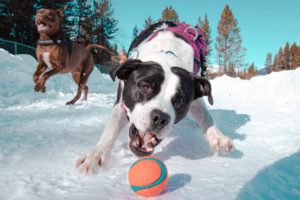

How long Can Dogs Go Without Food and Water?

PAWPRIDES, 12 FEB 2020
When your healthy eating dog refuses their food and water, the first question you may ask is how long can dogs go without food and water?
In your life as a dog owner you may come across a time when your playful doggo refuses to eat or drink water. It is critical that you understand the varying reasons why your dog might be going without food and water to ensure you take the right steps in treating your dog!
Dogs may refuse food when sick, depressed or simply because they dislike the food! Changes in your dogs eating habits are one of concern and it is always best practice to consult with a trusted veterinary clinic as soon as possible.

Photo by Camylla Battani on Unsplash
How long can dogs go without food?
Answers vary, with some vets stating 5 days for healthy dogs and others claiming up to 10. Keep in mind, this is only for healthy dogs consuming adequate amounts of water daily. If your dog is not in full health, they may only go without food for 1 or 2 days.
How long a dog can go without food depends on a few things including pre-existing medical conditions, how much water they’re drinking, weather and exercise. Just like humans, when dogs increase their resting metabolic rate (RMR), caloric requirements increase – less fasting time for your dog.
Refusing food can lead to outcomes such as:
- Dehydration
- Lethargy
- Sleep Issues
- Anxiety

Photo by Gavasinder Singh on Unsplash
Potential reasons why your dog has lost their appetite
Sometimes loss of appetite is not a life and death matter, it could simply be a food they dislike or a transition in environment. To stay on top, consider these common reasons as to why your dog has lost their appetite.
Food Allergies/Poisoning
Some dogs may have intolerances to particular foods causing allergies. If your dog vomits up their food see a vet asap.
Depression/Separation Anxiety
Dogs that are left home alone for long hours without any way of stimulation can develop separation anxiety: when your pup thinks you are avoiding them, resulting in anxious behaviours. Reduced food intake is a common result of this behaviour. In worst cases, they can stop eating all together.
Illness
The majority of loss-of-appetite scenarios are from illnesses. If your dog has refused food for 48 hours, contact your vet for professional assistance. Extreme illnesses like kidney failure, cancer, infections and pain will cause your dog to lose their appetite.
Dental Illness
A reduction of food intake purely from pain and discomfort. Much like humans, pain in the mouth can turn most away from eating. Dogs can develop cavities, gingivitis, oral tumours, loose and broken teeth. Play it safe and check your dogs mouth every so often.
Vaccination
Vaccinations may cause temporary side effects in your pup. One of these includes loss of appetite. This isn’t something to stress about as it will only last a few days.
Change in the environment
Small changes in your dogs environment can bring on a loss of appetite. If you notice this, look for environmental changes such as:
- Travelling
- New family members
- Change in weather
- Change in feeding schedule
- Absence of family member
- Moving houses
Fussy Eater
How would you feel if you had to eat the same meal day in and out? Exactly. This is how your dog feels. If your dog begins to eat less or refuse food they have eaten in the past, they’re most likely bored with what they’re eating.
On the same note, if a new food is refused they most likely do not like what you’re putting down. Some experts in the field recommend playing the waiting game as your dog won’t starve itself to death. However, if you’re new to owning dogs and feel uncomfortable with this, try these solutions:
- Try different flavours
- Try different brands
- Try different foods
Your dog may also refuse food when you go from home-cooked meals full of flavour, to flavourless wet kibble. Check to see the food is not spoiled, and consider if the smell and taste is different to previous given food.

Photo by Robert Eklund on Unsplash
How long can dogs go without food when sick?
Have you ever wanted to throw up at the smell of food when sick? Your dog can relate. Dogs often stop eating to help themselves recover faster when sick – the less energy spent digesting food, the more energy spent fighting illness!
While this is something that is beneficial for your dog, it is also something to monitor. More than two days without food can make situations worse. The American Academy of Veterinary Nutrition carried out a study in 2015 that looked at 490 dogs hospitalised for one day. They found that dogs who ate enough food to cover their resting energy requirements were more likely to be discharged alive. Those who didn’t came off not as fortunate.

Photo by Marek Szturc on Unsplash
What to do when your dog refuses food
We all know how gut wrenching vet trips are, however ruling out serious medical conditions will bring you much relief. If you’re in the clear or want to try some tactics first you can encourage your dog to eat with the following:
Create a calm environment
A calmer environment during meals times may encourage your dog to finish their food. To do this you can:
- Create a sanctuary for them to have their meals
- Give them privacy when they eat
- Make it physically easier for them to access their food (consider bowl size)
If you have more than one dog, move them into separate rooms when feeding.
Stop feeding treats
Dogs can refuse food when they get a lot of treats. Temporarily cut back on the treats and observe if they resume eating their food again.

Photo by Courtney Clayton on Unsplash
How long can a dog go without water?
Just like humans, dogs won’t survive long without water. Your dog may go without water for three days, however a healthy dog should never go without water for a day. If your dog goes three days without water they will need immediate hydration and medical intervention.
A general rule of thumb to follow is twice the amount of water to food.
‘If scruffy eats two cups of food, he will need five cups of water.’
More water may be required depending on the temperature. If it’s hot outside and you’re thirsty, good chance your dog is too.
It is important your dog has access to fresh clean water at all times. If you notice they haven’t drunk water from their bowl in 12 hours, contact your vet. This can result in dehydration which unfolds a plethora of problems.

Photo by Marian Kroell on Unsplash
Warning signs of dehydration
Dehydration is serious, and may lead to death if not acted upon straight away. Always check your dogs water bowl to see if they have been drinking the water you are giving them each day.
Reduced appetite
Like we mentioned earlier, dehydration can cause a lack of appetite. Dehydration makes it harder for your dog to digest and swallow food.
Lethargy
A lack of blood flow in the muscles will prevent energy throughout your dogs body resulting in a tried pup.
Sunken eyes
Check your dogs eyes. Dehydration will cause a lack of water behind the eye and can result in a sunken look. If you identify this, see a vet straight away.
Excessive panting
This is a clear and common warning sign of the onset of dehydration. This is more likely to happen on walks and hikes when you don’t have access to water. Do not let this go for long!
Dry nose and gums
The nose and gums of a healthy dog will be wet and moist. If dry, your dog may be dehydrated.
Low skin elasticity
Just like when we push on our skin to see if the blood rises back quickly, you can tug on your dogs skin to see if it immediately goes back into place. If your dog is dehydrated, the skin will hold its shape for much longer and take a few minutes to return to its intended position.

Photo by Treddy Chen on Unsplash
Tips to prevent dehydration in your dog
To ensure the health of your dog and keep them moving, follow these prevention tips!
Use hydrated food
Feeding dogs wet food is a simple and effective method to keeping them hydrated. This also works if they’re refusing water.
When preparing their food, just add water to the mix! Adding water to pellets is a super great hack. Ensure you allow 15 minutes for the water to be absorbed. If you feel like treating them, drop an ice cube on top.
COOL FACT – Canned food is 70% liquid.
Avoid salty foods
Foods high in salt may lead to excessive thirst, hypertension or high blood pressure. Avoid the following foods:
- Crisps
- Biscuits
- Bread
- Popcorn
Click here for more information on sodium in pet foods.
Take water on hikes
Light activity mixed with hot weather will increase the amount of water they need. Always bring water for your dog on hikes. A great way to tackle this is give them a drink every time you need one.
Leave their bowl in an accessible place
If your dog likes to spend time indoors and out, place a bowl in both areas so they always have access to water.
Make sure the bowl is big enough for your breed
If your dog is small and you have a gigantic bowl, chances are they will step inside and spill it. Get an appropriate sized bowl for your breed and make sure it holds enough water to cover 24 hours worth of water needs.
Refusal of food and water is a worrying situation for any dog owner, and must be handled as soon as possible. If you have any other tips, recommendations or questions, drop a comment below!
Follow us
Recent Posts




8 Tips For Living in an Apartment with Dogs | And What to Avoid!


Leave a Comment Cancel Reply




8 Tips For Living in an Apartment with Dogs | And What to Avoid!

